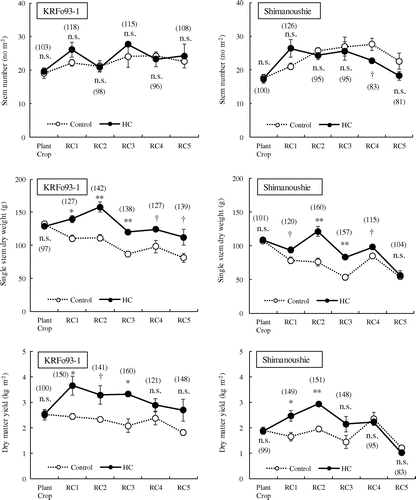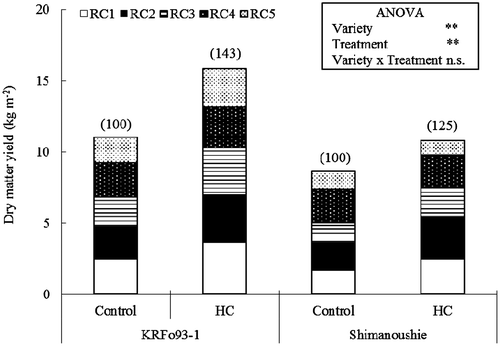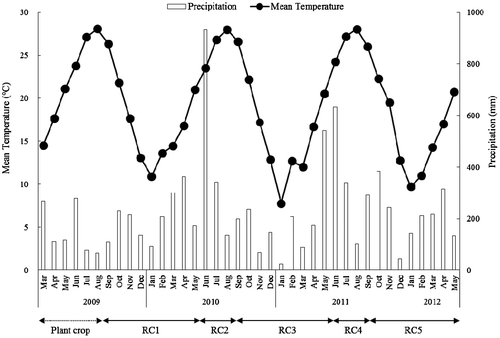Abstract
High-level cutting without stubble shaving has been recommended in the cultivation of forage sugarcane, KRFo93-1. However, it is unclear whether this management practice is appropriate for the more recently developed variety Shimanoushie. Therefore, the aim of this study was to compare the dry matter yield of both varieties to high-level cutting. The study included five ratoon crops (RC1–RC5). In KRFo93-1, dry matter yield was higher in HC plots (high-level cutting without stubble shaving plots) than in Control plots (stubble shaving after high-level cutting plots), and the differences were significant for the first three ratoon crops. A similar trend was observed in Shimanoushie; however, the dry matter yield of HC plots was slightly lower than Control plots in RC4 and RC5 owing to a lower stem number. Although the sum of dry matter yield of five ratoon crops was significantly higher in HC plots of both varieties, the influence of high-level cutting was more effective in KRFo93-1 than in Shimanoushie.
Classification:
The first Japanese variety of forage sugarcane was bred and registered as KRFo93-1 (Sakaigaichi & Terajima, Citation2008). The dry matter yield of KRFo93-1 is more than twice that of Rhodes grass, which is a widely grown grass species on the Nansei Islands of Japan. In contrast to sugar mill sugarcane, which is harvested at around ground level, forage sugarcane is harvested mechanically at about 15 cm above the ground as well as other forage crops because mixing of soil reduces silage quality. In addition, KRFo93-1 is also more adaptable to multiple ratooning than sugar mill sugarcane, which contributes to less labor-intensive cultivation. Thus, as a forage crop, forage sugarcane is expected to play an important role in improving feed production.
In the cultivation of sugar mill sugarcane, stubble shaving is performed to remove the residual stubble of the previous crop and promote ratoon growth (Ahmed & Giridharan, Citation2000; Parashar & Prasad, Citation1985; Yadav, Citation1992); whereas, in the production of feed crops, it is generally thought that high-level cutting increases the yield of the ratoon crop. In a previous study (Sakaigaichi et al., Citation2013), we investigated the difference of growth and yield of KRFo93-1 between stubble shaving after high-level cutting plot (Control plot) or high-level cutting without stubble shaving plot (HC plot), in order to clarify the effect of stubble shaving after high-level cutting. We found that the dry matter yield of the crop was significantly higher in the HC plots than in the Control plots and that the increase was the result of enhanced single stem dry weight. Therefore, we concluded that KRFo93-1 should be managed using high-level cutting without stubble shaving.
More recently, a second Japanese variety of forage sugarcane was bred and registered as Shimanoushie (Sakaigaichi et al., Citation2014). The ability of Shimanoushie to multiple ratooning is slightly inferior to that of KRFo93-1, so it is necessary to develop more appropriate management practices. However, it is unclear whether the varieties differ in their adaptability to high-level cutting. Therefore, the aim of the present study was to compare the growth and dry matter yield of KRFo93-1 and Shimanoushie in response to high-level cutting.
1. Materials and methods
1.1. Experimental design and plots management
The present study was conducted in an Andosol field at the National Agriculture and Food Research Organization (NARO) / Kyushu Okinawa Agricultural Research Center (KARC) Tanegashima sugarcane breeding site in Nishinoomote, Kagoshima Prefecture, Japan between 2009 and 2012, and the monthly mean temperature and precipitation of the experimental field were recorded by the meteorological equipment of the NARO/KARC Tanegashima sugarcane breeding site. To establish the plots, one-bud stem cuttings of KRFo93-1 and Shimanoushie were planted on 25 March 2009, at a planting density of 6.36 buds m−2, with 110 cm between rows and 14.3 cm between hills. After an initial harvest survey of the plant crop on 20 August 2009, shoots after the survey was removed by high-level cutting (about 15 cm above ground level) with a cane harvester on 21 August 2009, and Control and HC plots were established in order to investigate the influence of high-level cutting on the growth of the ratoon crops. We used a randomized block design with three replicates per treatment, and the area of each plot was 6.6 m2, with two 3.0 m rows in each plot.
For each crop, chemical fertilizer was applied as a basal dressing (7.2 g N m−2, 12.0 g P2O5 m−2, and 6.0 g K2O m−2) and as a topdressing (9.0 g N m−2, 0.0 g P2O5 m−2, and 9.0 g K2O m−2), and the crops were managed almost identical to sugar mill sugarcane, except without high earthing. Forage sugarcane is typically harvested twice per year (Sakaigaichi et al., Citation2015). In addition, whereas the Control plots received the same post-harvest management as sugar mill sugarcane after high-level cutting (i.e. stubble shaving) upon the initiation of regrowth, the HC plots were exempt from stubble shaving, and cultivation under the Control and HC plots management strategies was continued through the fifth ratoon crop (RC1–RC5; Figure ). Harvest surveys were conducted on 19 May, 2010, 19 August 2010, 20 May 2011, 22 August 2011, and 24 May 2012, for RC1–RC5, respectively; whereas the shoots after these surveys were harvested on 19 May 2010, 27 August 2010, 20 May 2011, 26 August 2011, for RC1–RC4, and stubble shaving was conducted immediately afterward.
1.2. Crop analysis
The stem number and single stem dry weight were measured during harvest surveys, which were conducted before harvesting on 19 May 2010, 19 August 2010, 20 May 2011, 22 August 2011, and 24 May 2012, for RC1–RC5, respectively. Stem number was defined as the number of tillers, excluding ‘suckers’, which we defined as small tillers that formed in the late growth period. Meanwhile, to measure stem dry weight, we sampled ten stems that exhibited healthy and typical growth from the two rows, chopped them into small pieces, and dried them at 80 °C for 48 h. Dry matter yield was then calculated as the product of stem number and single stem dry weight.
Subsequently, stem number, single stem dry weight, and dry matter yield of the Control and HC plots for each variety were statistically analyzed using t-tests (IBM Co., SPSS ver. 21.0), whereas the sum yield of the five ratoon crops (RC1–RC5) were analyzed using two-way factorial ANOVA (Treatment × Variety).
2. Results and discussion
2.1. Climatic conditions
The number of growing days were about three times longer for the RC1, RC3, and RC5 than for the RC2 and RC4 (Figure ); however, both RC2 and RC4 were grown during summer, when the mean temperature was much higher. In addition, no frost damage was observed during the study, since the site was located in the thermal belt. Since it rained constantly during the study period, it seemed that there was little growth restriction as a result of water shortage (visual observation). Furthermore, even though the several typhoons passed during the course of the study, the damage to leaves and stems was slight.
2.2. Influence of plot management on crop growth and yield
In the plant crop, there were no significant differences in stem number, single stem dry weight, or dry matter yield between the Control and HC plots for either KRFo93-1 or Shimanoushie (Figure ).
Figure 2. Effect of high-level cutting on the growth and yield of ratoon crops in two varieties of forage sugarcane. The plant crop was not treated with stubble shaving. Control: high-level cutting with stubble shaving, HC: high-level cutting without stubble shaving. RC1 to RC5: first to fifth ratoon crops.

In the present study, we investigated stem number, since the performance of ratoon crops is tightly linked with the ability of individual varieties to produce stems (Chapman, Citation1988; Singh et al., Citation2005) and consistent stem number is a major factor for obtaining high yields over multiple ratoon crops. In KRFo93-1, we found that the mean stem number of plants in the Control and HC plots were similar throughout the study period (RC1–RC5; Figure ). A similar trend was observed in Shimanoushie, although the stem number of plants in the HC plots was about 20% less than that of plants in the Control plots in the RC4 and RC5.
Single stem dry weight is another important factor for high yield. In the present study, the weights of KRFo93-1 stems were consistently greater in the HC plots than in the Control plots (p < 0.10; Figure ), in agreement with Sakaigaichi et al. (Citation2013). A similar trend was observed in Shimanoushie; however, the dry weights of stems from the HC and Control plots were almost the same in the RC5.
In KRFo93-1, dry matter yield was higher in the HC plots than in the Control plots, with significant differences observed in the RC1, RC2, and RC3 (Figure ). A similar trend was observed in Shimanoushie, although the dry matter yield of the HC plots was slightly lower than that of the Control plots in the RC4 and RC5, owing to a lower stem number. However, the sum of dry matter yield of five ratoon crops was significantly higher in the HC plots of both KRFo93-1 and Shimanoushie (Figure ).
Figure 3. Effect of high-level cutting on the sum yield of two varieties of forage sugarcane. Control: high-level cutting with stubble shaving, HC: high-level cutting without stubble shaving. RC1 to RC5: first to fifth ratoon crops.

2.3. Comparison of KRFo93-1 and Shimanoushie
The ability of Shimanoushie to multiple ratooning is slightly inferior to that of KRFo93-1 (Sakaigaichi et al., Citation2014). Therefore, the present study investigated the influence of omitting stubble shaving after high-level cutting in Shimanoushie. The sum of dry matter yield of both varieties were higher in the HC plots (Figure ); however, in Shimanoushie, the dry matter yield of the HC plots was slightly lower than that of the Control plots in the later ratoon crops, i.e. RC4 and RC5 without significant differences (Figure ).
Because of the apical dominance, tillers emerged from the above ground nodes in HC plots of both varieties. However, these tillers did not survive due to shading by tillers emerged from the below ground nodes, as shown in Sakaigaichi et al. (Citation2013). In the present study, the plant type, especially the basal part of the stem in KRFo93-1 was more erect than that of Shimanoushie (visual observation). Therefore, the number of non-productive tillers from the above ground nodes was assumed to be higher in HC plots of Shimanoushie than those of KRFo93-1. This repeated high-level cutting could reduce the stem number of RC4 and RC5 in HC plots of Shimanoushie.
The soil depth from which shoots emerge at the start of the ratoon crop is very important, and stubble shaving functions to prevent concentrating the rooting zone at the soil surface (Yadav, Citation1992). Roots have the function of absorbing water and nutrients. Root mass of a stem generated at shallow soil depth is smaller than that generated at deep soil depth because of the limited rooting zone (Miyahira & Kamiya, Citation1984). Although there is no scientific evidence on this aspect, the absence of single dry weights of RC5 in HC plots of Shimanoushie could result from the limited rooting zone through repeated high-level cutting.
Although we only investigated the influence of high-level cutting over five ratoon crops, whereas forage sugarcane is normally grown for at least ten ratoon crops. Considering the trend of stem number and single stem dry weight in HC plots of Shimanousie (Figure ), crops of RC6 or later in HC plots would indicate less yield productivity. In conclusion, our results suggest that the continuous omission of stubble shaving was less beneficial for Shimanoushie. As shown in this study, it took longer to evaluate the adaptability of high-level cutting in multiple ratooning . Further studies based on plant type and belowground characteristics are needed to develop the selection index of the adaptability of high-level cutting, found in early ratoon crops such as RC1 and RC2.
Disclosure statement
No potential conflict of interest was reported by the authors.
Acknowledgments
We are grateful for scientific advice from Dr Y. Tarumoto, Dr A. Sugimoto, and current members of the sugarcane-breeding group of NARO/KARC. We also appreciate the technical assistance of Mr M. Kubo, Mr Y. Oitate, Mr M. Habu, Mr S. Yano, Mr C. Sugimatsu, Mr N. Matsuzaki, Mr T. Yoshida, and Mr N. Matsuoka, NARO/KARC. We would like to thank Editage (www.editage.jp) for English language editing.
References
- Ahmed, S. N., & Giridharan, S. (2000). Study on the influence of management practices on sugarcane ratoon crops. Indian Sugar, 49, 835–837.
- Chapman, L. S. (1988). Constraints to production in ratoon crops. Proceedings of Australian Society of Sugar Cane Technologists, 10, 189–192.
- Miyahira, E., & Kamiya, J. (1984). Study on system of ratoon shoots in sugarcane. Bulletin of Okinawa Agricultural Experimental Station, 9, 59–66.**
- Parashar, K. S., & Prasad, A. (1985). Studies on various intercropping and management practices on yield attributes, yield and juice quality of first sugarcane ratoon. Indian Sugar, 35, 121–125.
- Sakaigaichi, T., & Terajima, Y. (2008). Development and extension of sugarcane cultivar as forage crop ‘KRFo93-1’. Journal of Agricultural Science, 63, 24–29.***
- Sakaigaichi, T., Terajima, Y., Terauchi, T., Hattori, T., Ishikawa, S., Hattori, I., … Matsuoka, M. (2013). Effect of stubble shaving after high-level cutting on the growth and yield of forage sugarcane, KRFo93-1, under multiple ratooning cultivation. Plant Production Science, 16, 183–190.10.1626/pps.16.183
- Sakaigaichi, T., Terauchi, T., Terajima, Y., Hattori, I., Matsuoka, M., Sugimoto, A., … Shimoda, S. (2014). New forage sugarcane cultivar ‘Shimanoushie’ with smut resistance and high yield. Bulletin of NARO Kyushu Okinawa Agricultural Research Center, 62, 41–51.**
- Sakaigaichi, T., Tarumoto, Y., Hattori, I., Maruyama, A., Terauchi, T., Matsuoka, M., … Terajima, Y. (2015). The growth and yield of KRFo93-1 as forage sugarcane variety under two harvests per year at different harvest times. Japanese journal of crop science, 84, 41–48.*10.1626/jcs.84.41
- Singh, R. K., Singh, S. P., & Singh, S. B. (2005). Correlation and path analysis in sugarcane ratoon. Sugar Tech, 7, 176–178.10.1007/BF02950610
- Yadav, R. L. (1992). Stubble shaving. In R. L. Yadav (Ed.), Ratooning of sugarcane (pp. 127–130). Delhi: Periodical Experts Book Agency.
